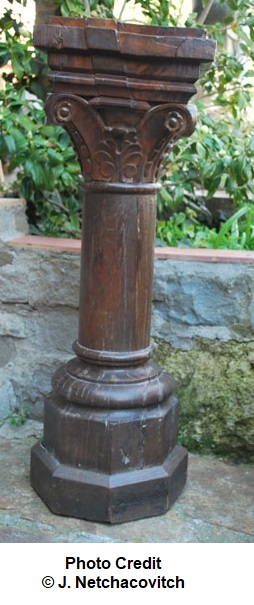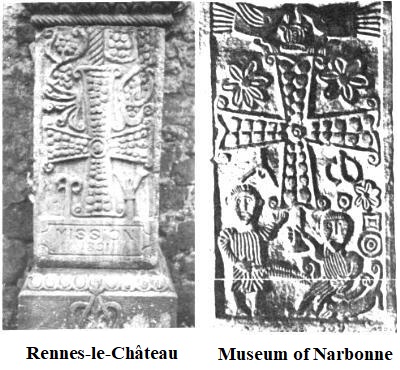The Baluster and 1891 Pillar of Rennes-le-Château
Paul Smith
19 July 2017
Revised & Corrected 3 August 2018
The Baluster and 1891 Pillar of Rennes-le-Château – both peddled as “relics” of Bérenger Saunière and Rennes-le-Château by the Municipality and Tourist Board of Rennes-le-Château – lack any historical credence.
The Baluster

A restored and duplicate version of the 1891 baluster, containing a hypothetical cavity where a vial was once allegedly concealed, was placed in the Saunière Museum in Rennes-le-Château.
Questions and doubts have been raised about the original 1891 baluster.
The physical object itself does not seem to date from 1892. The story about the baluster does not date from 1892 or from Bérenger Saunière’s lifetime. It was first referred to in dramatised form in an early black and white French 1960s documentary about Bérenger Saunière. The story about it wasn’t committed to writing until 1985 in the book L’Héritage de l’Abbé Saunière by Corbu and Captier.
“Oral traditions” – as we know from the testimonies of those associated with the Roswell “flying saucer crash”, for example – can be completely unreliable and meaningless, because of the formation of accretions.
People who examined the baluster when it was dismantled by Marcel Captier during the 1990s to show it had a “cavity”, couldn’t see any cavity and were unable to figure out where a phial could have been placed inside the baluster.
The 1891 Pillar

Opinion is divided about the 1891 Pillar. Some people claim it is Visigothic, some claim it is Carolingian, others claim it dates from 1891 (eg, René Descadeillas, Christopher Scargill).
There are no references to the existence of the 1891 Pillar before that year when Saunière used it as a base for the statue of Notre Dame de Lourdes. There is a story in one of the archaeological bulletins of the early 1900s that Saunière claimed it was one of the pillars that supported the Main Altar in his church [*], but Saunière’s account cannot be trusted because of his dishonesty during his Ecclesiastical Trial 1910-1911 (his bogus “List of Donors” to hide the fact he was trafficking in masses). The main altar of the church of Rennes-le-Château supported by pillars is not found in any Church Report.
It is most likely that the 1891 pillar is modelled on a Carolingian Pillar found in the Museum of Narbonne, and in some way linked to the Lazarists of Notre Dame de Marceille (also called the Congregation of the Mission), that Saunière perhaps would have met when he was transferred to the Petit Seminaire de Narbonne.

The local cult of Notre Dame de Lourdes was established in 1890. The church of Notre Dame de Marceille (a Marian shrine) would have been glad to assist Saunière with the installation of the statue of Notre Dame de Lourdes in 1891 and this would explain the presence of a Lazarist priest at the installation ceremony in Rennes-le-Château. Perhaps the 1891 Pillar was donated by the Lazarist priests of Notre Dame de Marceille. Saunière was devoted to the Lourdes Cult, having ventured on three pilgrimages in August 1911, August 1913 and October 1915; also hoping to retire to Lourdes after losing his Ecclesiastical Trial and stripped of his priesthood.
The words “Mission 1891” would have doubled-up the Statue of Notre Dame de Lourdes as a Mission Cross or Calvaire (the Calvary wasn’t installed in the village until a few years later, again in the presence of a Lazarist priest from Notre Dame de Marceille).
To sum up:
The baluster: highly unreliable as a physical object dating from 1891 or 1892; the story about it lacks validity and provenance. The story was probably invented by Noël Corbu for the 1960s French documentary.
The 1891 Pillar: there are no references for its existence before 1891, and it could simply have been part of the installation of the statue of Notre Dame de Lourdes, modelled on a similar Carolingian Pillar found in Narbonne Museum.
Footnote
[*]“According to Abbé Saunières [sic], the high altar was made up of a large slab set on its side in the wall and held up in front by two pillars” (M. A. Fages, ‘From Campagne-les-Bains To Rennes-le-Château’, Bulletin of the Society for Scientific Study of the Aude, Volume 20, 1909).
|


